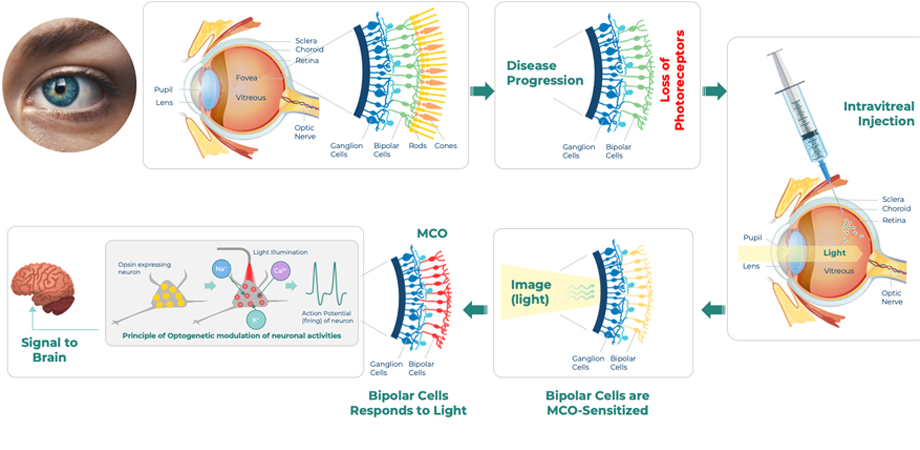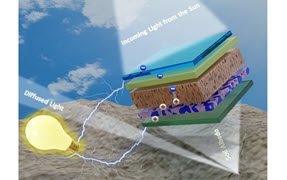Optogenetics a promising route to vision restoration

Loss of eyesight can be the result of many different conditions, with inherited retinal disease thought to be the most common cause of blindness in developed countries. Management has tended to involve supportive measures rather than cures, although significant surgical procedures using retinal implants of several different kinds have also been developed.
Optogenetics, in which the activity of neurons or other cells is influenced by incident light, could offer a more attractive solution. It may be possible to use an optogenetics approach to render secondary and tertiary neurons of the retina light sensitive, allowing them to effectively take the place of the degenerate or dysfunctional receptors responsible for the loss of vision.
This topic was the subject of a session in the Optogenetics and Optical Manipulation conference at SPIE Photonics West in January, where Samarendra Mohanty and a team from Nanoscope updated attendees on the latest breakthroughs in the field for treatment of different retinal disorders.
"Optogenetics can make surviving neurons photosensitive, so as to replace the light-sensing function of the non-functioning photoreceptors," commented Mohanty. "To make them suitably light-sensitive, for example sensitive to a broadband ambient environment, depends on appropriate molecular engineering plus the sensitivity of the optogenetic probe.
"The opsin protein that we use, delivered using an adeno-associated virus (AAV) as a vector, has to be sensitive enough that neurons can be activated at low light levels without causing phototoxicity. Optogenetics involving molecules designed from microbes generally works as a single component system, whereas natural vision transduction in humans involves the interplay of several molecules, so the opsin kinetics has to be fast enough to allow visual processing of moving scenes," Mohanty added.
The challenge with an opsin approach is to have all the ideal characteristics, such as high sensitivity, broad spectral response and fast on-off response, present and distinguishable in one practical system. Nanoscope Technologies has developed an opsin named Multi-Characteristic Opsin, in which the unique structure — a transmembrane ion channel coupled to a ligand and enhancer — is said to lead to a distinct mechanism of action. The intention is to allow the dynamic range of the optogenetic vision restoration to approach that of the several complementary mechanisms used in a natural eye.
"Another issue relates to the delivery of opsin so as to achieve high transduction in target cells without causing inflammation," said Mohanty. "Our high dose AAV vector has shown limited and well controlled inflammation over a long period, while other viral vectors at high dose may lead to long-term adverse effects. Therefore it needs to be rigorously studied and controlled," Mohanty said.
Challenges being tackled
Other approaches to vision restoration can employ a combination of an opsin and an external device. While the optogenetic approach being taken by Nanoscope Technologies does not require the use of any intensifying goggles, instead exploiting the bespoke properties of the opsin, alternative methods can employ eyewear as part of combined optical platforms intended to capture an external scene with a camera and relay it to the retina as a scanning light beam. In these combination therapy approaches, control of the delivered light's pulse and intensity is essential, often exploiting current photonics technologies such as MEMS devices, sensors and image processing algorithms to enhance the overall performance.
"Some versions of these therapies use light intensifying goggles, and others use smart goggles that transform the light pattern, conditioning it as would normally have happened in the upstream retinal circuit," commented Ehud Isacoff from the University of California, Berkeley, who will discuss the use of rod and cone opsin for optogenetic vision restoration during the conference.
"We need a system that is sensitive enough to work in room light and on standard computer displays, one that provides high acuity, and is fast enough to prevent blurring when subject or surround are in motion. And gene delivery must be across as much of the retina as possible while also selective for a cell type that is densely represented, in order to provide acuity," said Isacoff.

Optogenetic approach does not require the use of any intensifying goggles. Credit: Nanoscope Technologies
In addition, if photochemicals are used then they must demonstrate long-lasting slow release to minimize frequency of injection. The overall vision restoration system must be capable of being switched off if it proves to have an undesired effect, and ideally should be upgradable. "The list of challenges is daunting," commented Isacoff. "But we are getting there. Many boxes have already been checked, and we have cleared a path to the rest."
Clinically meaningful vision improvements
The hurdle for combination therapy using optical devices alongside opsin, according to Samarendra Mohanty, is to make sure that the phototoxicity over prolonged use is limited. A further challenge is to match the projected simulation beam with the opsin-transduced cells in the retina, which can be patchy or arranged in a ring format. The system may even need to track eye movement and simultaneously reposition the scanning beam with respect to the transduced areas of the retina.
In 2021, Nanoscope released results from a clinical trial in which the company's optogenetic gene therapy restored clinically meaningful vision to 11 patients blinded by retinitis pigmentosa. These results represented the first clinically meaningful functional improvement achieved by optogenetic therapy, according to the company, with further positive results expected to follow.
"We are in a late-stage clinical development program, a multi-center double-masked randomized trial in US, with very exciting data that should expedite bringing the therapy to patients," noted the company at the time. "With our Multi-Characteristic Opsin and viral/non-viral delivery platforms, we hope to address a wide patient population with severely degenerated or partially-degenerated retina."
Alongside this progress in restoring vision to those who have lost it, optogenetics could also address patients with a partially degenerated retina, tackling geographic atrophy in dry AMD and thus addressing another widely encountered disease. This will require localization of the opsin delivery to the atrophic areas only.
"We have developed an OCT-guided optical non-viral delivery approach to deliver opsin-encoding genes to target areas of the retina," commented Mohanty. "This eliminates the inflammation that can arise from using viral capsids, and also allows us to re-dose the subject in the same and newly evolved atrophic areas in these progressive retinal degenerative diseases, or deliver an improved opsin."
Tim Hayes is a freelance writer based in the UK. He was previously industry editor of optics.org and Optics & Laser Europe magazine. This article originally appeared in the 2022 SPIE Photonics West Show Daily.
| Enjoy this article? Get similar news in your inbox |
|



